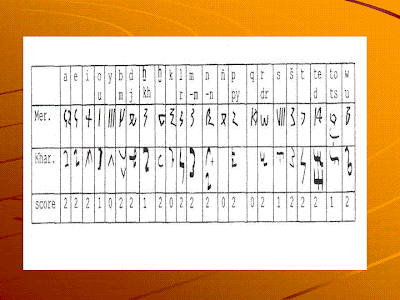4. Burlak argues that Tocharian text do not date back to the 2nd Century BC.
The Tocharian language was written in Kharosthi script. This script was used to write the Gandhararan Buddist Text. According to Glass (2000) the Kharosthi script appears fully developed in the Asokan inscriptions of Shahbazgarhi and Mansehra. These inscriptions date back to 3rd Century BC (Glass, 2000 p.20). It continued to be used in Gandhara, Kushan and Sogdian.
Glass provides evidence that Kharosthi writing dates back to the first Brahmi inscriptions of India (Glass, 2000 pp.20-21). The fact the writing was used in India by Asoka to produce the rock edicts (Glass, 2000) , demonstrates that Khasrothi was in use long before the introduction of the Meroitic script to Kush.
The Meroitic script resembles many Khaorsthi signs. Some researchers argue that the Meroites did not adopt the writing system of the Kushana/Tocharian people which was Kharosthi. Although this is their opinion a comparison of the Meroitic and Kharosthi symbols make it clear that both writing systems share many cognate signs.
Aubin (2003) did a comparison of Meroitic and Kharothi and discovered that 34 out of 42 signs or 81% matched.
Figure 1 : Aubin (2003) Comparison of Meroitic and Kharosthi Signs

Since Tocharian was written is Kharosthi the cognition between Kharosthi and Meroitic is quite interesting and shows some connection between these scripts. It also offers additional support to the Tocharian origin of Meroitic writing given the analogy between the signs.
Let's not forget that Welsby in The Kingdom of Kush, notes that "only four of the [Meroitic] letters resemble the equivalent Egyptian demotic signs" (p.193) But as you can see from the above there are more than four Kharosthi signs that match Meroitic, and even more of these signs match Kharosthi.
The summary , Kharosthi script dates back to the 3rd Century BC. It was used to write Tocharian inscriptions. This makes it clear that Kharosthi was in use long before the Meroitic script was created.
References:
Aubin,P. (2003). Evidence for an Early Nubian Dialect in Meroitic Inscriptions: Phonological and Epigraphic Considerations. Meroitic Newsletter, pp.16-39.
Glass, A. (2000). A Preliminary Study of Kharosthi Manuscript Paleography. M.A. Thesis. University of Washington.

No comments:
Post a Comment